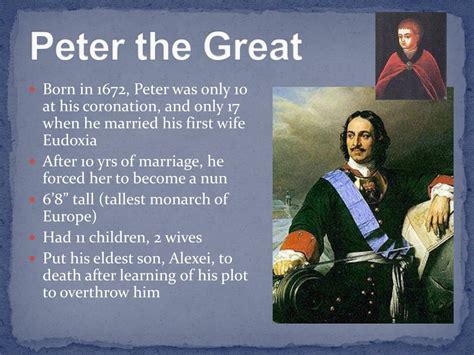Peter the Great, who reigned as Tsar of Russia from 1682 to 1725, is widely regarded as one of the most influential and transformative rulers in Russian history. His reign was marked by a series of sweeping reforms and ambitious military campaigns that aimed to modernize Russia and expand its borders. However, the question of whether Peter was an absolute monarch remains a topic of debate among historians.

Defining Absolute Monarchy
Before examining Peter’s reign, it is essential to define absolute monarchy. Absolute monarchy is a form of government in which the ruler wields supreme authority without any limitations or constitutional constraints. The monarch possesses absolute power to make and enforce laws, levy taxes, declare war, and dispense justice.
Peter’s Rise to Power
Peter became Tsar at the age of ten after the death of his half-brother, Tsar Feodor III. However, the early years of his reign were overshadowed by the dominance of his older half-sister, Sophia Alekseyevna. Peter’s subsequent rise to power was marked by a series of conflicts and power struggles.
Reforms and Modernization
Throughout his reign, Peter implemented a series of far-reaching reforms aimed at transforming Russia into a modern European state. These reforms included:
- The introduction of a new alphabet and the establishment of schools
- The reorganization of the army and navy along Western lines
- The creation of a new system of government administration
- The promotion of trade and industry
These reforms were designed to strengthen Russia’s military, economy, and cultural standing in Europe.
Military Campaigns and Expansion
Peter was also an ambitious military leader who waged numerous wars to expand Russia’s borders. His most significant conquests included:
- The Great Northern War against Sweden, which resulted in Russia’s acquisition of territory along the Baltic Sea
- The Persian Campaign, which expanded Russian influence in the Caucasus
- The Pruth Campaign, which secured Russia’s access to the Black Sea
These military campaigns dramatically increased Russia’s size and influence, solidifying its position as a major European power.
Autocratic Rule
While Peter’s reforms and military victories contributed to the modernization and expansion of Russia, they were often implemented with an iron fist. Peter suppressed all forms of opposition and dissent, and he established a secret police force to root out and punish those who dared to criticize his rule.
Limitations on Power
Despite Peter’s authoritarian tendencies, there were certain limitations on his power. These limitations included:
- The Boyar Duma, an advisory council of nobles who could provide input and advice
- The Streltsy, an elite military force that could pose a threat to the Tsar’s authority
- The Orthodox Church, which maintained a significant degree of influence and autonomy
These factors suggest that Peter’s rule fell short of absolute monarchy in the strictest sense.
Conclusion
The question of whether Peter the Great was an absolute monarch is complex and nuanced. While he possessed immense power and authority, there were certain limitations on his rule. His reforms and military campaigns undoubtedly transformed Russia, but they were implemented with an autocratic hand. In conclusion, Peter’s reign represents a hybrid of absolute monarchy and more limited forms of sovereign authority.
Table 1: Peter’s Key Reforms
| Reform | Purpose |
|---|---|
| New alphabet and schools | To increase literacy and promote European ideas |
| Army and navy reorganization | To strengthen Russia’s military capability |
| Government administration reorganization | To streamline government operations |
| Trade and industry promotion | To boost the economy and modernize Russia |
Table 2: Peter’s Major Military Campaigns
| Campaign | Period | Outcome |
|---|---|---|
| Great Northern War | 1700-1721 | Russian victory and acquisition of territory along the Baltic Sea |
| Persian Campaign | 1722-1723 | Russian victory and expansion of influence in the Caucasus |
| Pruth Campaign | 1710-1711 | Stalemate, but secured Russian access to the Black Sea |
Table 3: Limitations on Peter’s Power
| Limitation | Reason |
|---|---|
| Boyar Duma | Advisory council of nobles could provide input |
| Streltsy | Elite military force could threaten Tsar’s authority |
| Orthodox Church | Maintained significant influence and autonomy |
Table 4: Peter’s Impact on Russia
| Impact | Description |
|---|---|
| Modernization | Reforms transformed Russia into a more modern European state |
| Expansion | Military campaigns increased Russia’s size and influence |
| Centralization | Peter strengthened the central government and suppressed opposition |
| Legacy | Peter’s reforms and achievements continue to shape Russia today |
